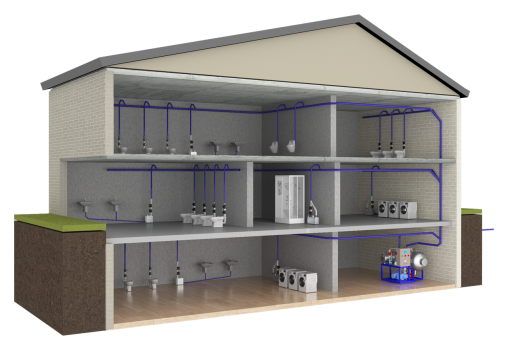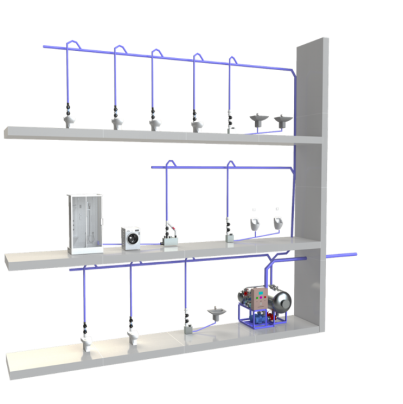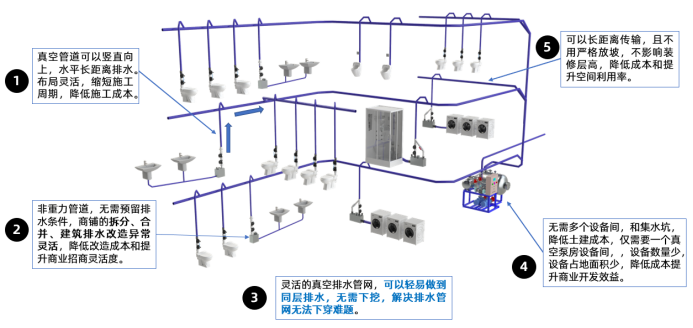Guide to Vacuum Drainage Systems
Guide to Vacuum Drainage Systems
Flexible and efficient drainage systems
Catalogues
1. What is a vacuum drainage system?
2. How a vacuum system works
3. Advantages of Juchuan Environmental Protection Vacuum Drainage System
4. Design stage advantages: Greater flexibility, better creativity and more options
5. Advantages in the installation phase: Easier, faster and hassle-free installation
6. Post-installation advantages: Benefits for the environment, health, and economy
7. Common misconceptions about vacuum drainage systems
8. Benefits for buildings and the environment
9. Why choose a vacuum system over a gravity system?
10. Contact Information
1. What is a vacuum drainage system?
An indoor vacuum drainage system is a type of drainage system that uses negative pressure drainage, which is different from traditional gravity drainage systems and pressure (positive pressure) drainage systems. Compared with traditional drainage systems, it has unique advantages such as being environmentally friendly, water-saving, having good system airtightness, flexible drainage pipe laying methods, and convenient and quick construction.
Unlike traditional gravity-based drainage solutions, vacuum systems transport wastewater efficiently through pressure differences in air-water mixtures by creating a strong vacuum.

2. Working principle of vacuum system
The main components of a vacuum system include a vacuum interface, a vacuum toilet, and a vacuum collection device. The vacuum generator creates a vacuum in the pipe through a vacuum pump. When the toilet flushes, the higher pressure atmospheric air flows through the toilet or interface into the lower pressure pipe. Due to the pressure difference, the air flows at high speed, carrying the wastewater along.
The vacuum drainage system is mainly composed of vacuum units, vacuum pipelines, vacuum toilets, vacuum lifters, etc.

Typically, one flush of the toilet can transport wastewater 10 to 25 meters to the next transport point, where a water plug is formed. When flushing again, the wastewater moves another 10 to 25 meters until it finally reaches the collection device. From here, it can be lifted to where it is needed or discharged into the sewer.
3 Advantages of a vacuum drainage system
Design flexibility:
· With smaller pipes, greater flexibility can be achieved by bypassing obstacles for horizontal or vertical transportation without the need for a continuous slope.
· Eliminating the need for floor penetration.
· There is no need to build lift stations underground to collect wastewater at multiple points.
Reliability:
· Due to the high flow rate of water in vacuum pipes, there are almost no clogging and deposition problems.
· A pipe rupture will only cause air to leak, not wastewater to leak into the room.
· Ventilation ducts that no longer require equipment and interfaces.
Reduce installation time:
· Easier and more economical for building renovations, underground installations, store refurbishments, or historic building restorations.
· Offer more layout options and flexibility, reduce the need for drilling, and make installation quicker and more cost-effective.
Save water
· Save up to 90 percent more flushing water than a standard toilet.
· A vacuum toilet uses only 0.8-1.2 liters of water per flush.

4 Advantages of the design stage: greater flexibility, better creativity and more options
Vacuum technology has been around for over a hundred years, allowing designers to make bolder and more cost-effective architectural design choices and simplifying construction challenges. With the use of vacuum technology, wastewater can be transported horizontally or vertically around obstacles without the need for continuous slopes, which means there are more piping design options available. It also eliminates the need to dig up the ground to build a lift station.
The use of smaller pipes makes design and installation simpler and more flexible. The vacuum system also avoids the traditional stack design, as the vacuum drain pipe can be lifted up with a small diameter pipe. With a vacuum system, you can place sanitary equipment anywhere in the building and easily add drains and fixtures without major engineering work. This not only gives you the freedom to design the building, but also helps you make more efficient use of valuable space.
5. Advantages of the installation phase: Easier, faster and hassle-free installation
Sometimes, traditional gravity drainage systems are costly, fail to meet design goals or, in many cases, do not work. Vacuum technology is not only easier to install, but also offers greater flexibility, allowing for easier on-site modifications, which is more economical in the long term.
Last-minute modifications become simple:
One of the main benefits of choosing vacuum technology is that it allows you to make the final modifications easily. For gravity systems, large pipes, numerous grooves, and the need for drilling can complicate things. Smaller PVC pipes allow you to make quick and simple modifications and additions to functionality in a short time.
Smarter and more efficient installation:
Installing a vacuum system is less troublesome. Wastewater pipes are usually laid out from the ceiling, reducing the need for grooves and saving time and costs for new and retrofit projects. Avoiding the risk of cutting wires, drinking water pipes and sewers in the floor slab. In addition, it reduces or eliminates the need for floor X-ray inspections, allowing the building and historical features to be preserved.
Underground installation becomes simple:
Underground installation becomes simpler and more economical, without the need for lift stations. This makes it more feasible to install toilets in places like subway stations. Vacuum technology offers versatility in underground and suspended floor slab buildings, reducing or eliminating the need for core holes and floor penetrations, roof penetrations, floor drains and clean openings. You can have a single collection point without multiple lift stations, making the wastewater collection point at the same level as the bathroom, kitchen, and other drainage collection points.
Flexible supermarket design for collecting condensate:
Unlike traditional gravity drainage, vacuum generators transport condensate by removing air. Juchuan Environmental Technology prepares for future expansion and speeds up construction progress. Displays can be easily replaced overnight, additional cooling space is added, and store layout designs are more flexible.
Ideal choice in challenging environments
In environments where underground excavation is not possible, such as archaeological sites, high water levels, or contaminated land, vacuum systems offer an efficient and non-invasive above-ground solution that saves you time, significant costs, and delays.
Reduce distractions and make it more convenient:
Lower dust and foundation engineering levels and higher on-site safety significantly reduce disruption to current tenants. When redecorating or installing a vacuum system, there is no need to access departments or tenant Spaces on lower floors. When renovations are carried out while the store remains open, the safety hazard on the sales floor is reduced. Toilets installed on the ground floor make the vacuum system an ideal choice for subway stations, as people with mobility issues don't have to climb to the upper floors to use the toilet.
6 Advantages after installation: Benefits for the environment, health and economy
With the improvement of public health standards, vacuum technology has shown obvious advantages in addressing common issues such as water usage, hygiene and overall comfort.
Save up to 90% of water:
A vacuum toilet uses only 1.2 liters of water per flush, while a traditional double-flush toilet uses 4-9 liters per flush. The vacuum system can also separate grey water from black water, allowing recycled grey water to be used for other non-potable purposes. Choosing a vacuum system can help your building obtain green building certification.
Improving hygiene, health and comfort:
Vacuum interfaces and toilets provide a cleaner environment than traditional gravity toilets. Gravity systems can cause an overspray of up to 80,000 contaminated droplets that can remain suspended in the air for hours, while vacuum toilets draw in 60 liters of air when flushed, suppressing the risk of contaminated fog, odors, and bacteria.
Long-term significant savings:
In addition to savings during the design and installation phases, choosing a vacuum drainage system can also significantly reduce operating costs, save water and reduce wastewater treatment expenses. Maintenance costs are also reduced as vacuum technology significantly reduces clogging of main pipes and exposes the pipes, making maintenance and cleaning easier. The use of vacuum systems in high-rise buildings reduces the amount of drinking water that needs to be lifted to the top of the building and saves energy costs.
Easy to maintain and repair:
Choose a vacuum drainage system to ensure smooth and efficient operation and easy management and troubleshooting. The system can be monitored and controlled through a user-friendly interface. No matter where your building, business, store or office is located, we can ensure high quality service. We offer full support from design to maintenance and train local people when needed.
7. Common misconceptions about vacuum drainage systems
Not New technology:
Vacuum drainage technology has a history of over 100 years and has solved problems that gravity drainage cannot. Juchuan Environmental Protection was founded in 2006 and has completed more than 4,500 vacuum drainage systems.
Not expensive:
Vacuum drainage systems offer flexibility when designing, constructing, and modernizing buildings, allowing for cost-effective work. Weather delays are reduced or eliminated, and the time and cost required to change orders are also reduced. Vacuum collection systems can achieve a short return on investment due to lower costs of water and wastewater.
Not only for aircraft and cruise ships:
Vacuum drainage systems are not limited to aircraft, ocean or train toilets. Our vacuum drainage system has successfully provided design flexibility, efficiency, ease of retrofit, cost-effectiveness and significant water savings for buildings around the world. Vacuum toilets are also more comfortable and hygienic, effectively removing odors and fog.
Not complicated:
Vacuum drainage technology is a complete piping system that follows simpler rules than traditional gravity drainage systems. Easy and efficient to install - pipes can easily bypass construction obstacles and avoid complex and costly structural alterations. Underground installation becomes simple and economical without the need for a lift station.
8 Benefits for buildings and the environment
Resource conservation:
Our energy-efficient vacuum collection system plays a significant role in conserving the world's scarce water resources, reducing waste, and achieving your environmental goals through smart solutions.
Reduce the amount of wastewater treated:
Reduce the amount of wastewater that needs to be treated, thereby reducing equipment and energy consumption.
Save water and energy:
The use of vacuum systems in high-rise buildings reduces the amount of fresh water that needs to be lifted to the upper floors.
Save material resources:
Smaller pipes mean less plastic is used, no trenches are needed, less concrete is used, the construction site is cleaner, and there is less dust.
Conversion of building use
The flexibility of vacuum systems makes it easier and more economical to renovate existing buildings.
Protecting sensitive environments:
The absence of underground piping makes vacuum technology particularly suitable for protected areas and fragile ecosystems.
9. Why choose a vacuum system over a gravity system?
Pipes:
· Vacuum systems use small-diameter pipes.
· Gravity systems use large-diameter pipes.
Toilets and interfaces:
· The vacuum toilet comes with an integrated interface to isolate the vacuum environment when not in use and has a parallel grey water interface.
· Gravity toilets require drain pipes and steep slope pipes as well as ventilation.
Water consumption:
· The vacuum system uses vacuum suction and water bags for transportation, requiring only 1.2 liters per flush.
· Gravity systems require a continuous slope and use 4-9 liters per flush.
Design and operation:
· Vacuum systems offer design flexibility for vertical lifting, horizontal transportation, small diameter piping, and bypassing obstacles.
· The gravity system requires a slope, a slow flow rate and can only flow downward to adapt to the constraints of the gravity system.
Hygiene:
· The vacuum system is not oversprayed. Each flush, the vacuum toilet sucks in 60-70 liters of air to remove odors, fog, and bacteria. When the pipe breaks, only air leaks, not water.
· The gravity system will produce overspray and suspend it in the air. When a pipe bursts, both wastewater and air leak.
10. Contact information
Hangzhou Juchuan Environmental Technology Co., LTD
Hangzhou Headquarters
MB/WhatApp:+86 18780008896
E-mail:408204113@qq.com
Address: Room 1503, Building 1, Qiantang Aviation Building, Shangcheng District, Hangzhou City, Zhejiang Province
![]() Guide to Vacuum Drainage Systems.pdf
Guide to Vacuum Drainage Systems.pdf